Back to Don's Maps
Nets and skis from ancient times
Helsinki Museum
Oldest net preserved in mud
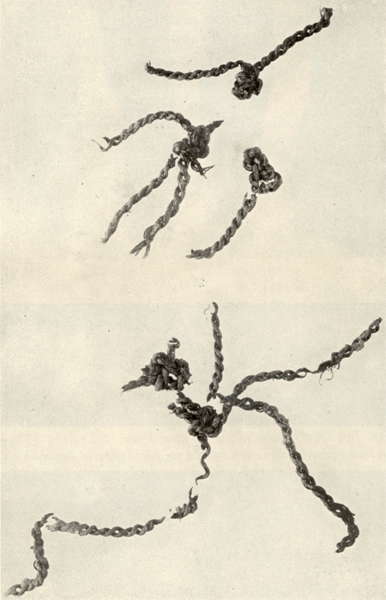
The Antrea Net is the oldest known fishing net in the world, dated 9310±120 BP with radiocarbon dating. It was found by a farmer named Antti Virolainen in Antrea, Finland (today Kamennogorsk, Russia) in autumn 1913, while he was ditching a swamp meadow. The place was then excavated by the Finnish archaeologist Sakari Pälsä. The net is made out of willow and it is 30 metres wide and 1.5 meters long. The loops are 6 centimetres in size.
The net had sunk to the bottom clay of the Ancylus Lake that existed during that period, most likely in an accident that made the fisherman's boat capsize and lose all his equipment. Along the net various tools were found, including hunting weapons, fist-sized rock weights, floats made from Scots Pine bark and other tools made out of bones.
The Antrea Net is on display in the National Museum of Finland.
Photo: Sakari Pälsi 1920
Permission: Public Domain
Text: Wikipedia
This net measured 27 - 30 metres x 1.3 - 1.5 metres, with a 6 cm mesh. The find included a bone point with small quartz blades on one side, and axe of antler, and various stone artefacts, pieces of quartz and pieces of raw material. A perforated bone object may have been a flute. The net was made of willow bast and two of its knots were so well preserved that they could be reconstructed. Sakari Pälsi, who excavated the find, identified the knot as belonging to a type with existing ethnographic parallels known only from Estonia and the eastern regions of the Finno-Ugrian peoples.
Text above from the National Museum of Finland.
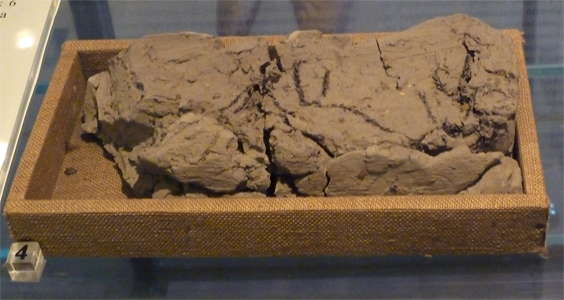
The display of the actual net.
Photo: Ralph Frenken
Source: The National Museum of Finland, Suomen kansallismuseo presents Finnish history from the Stone Age to the present day, through objects and cultural history.
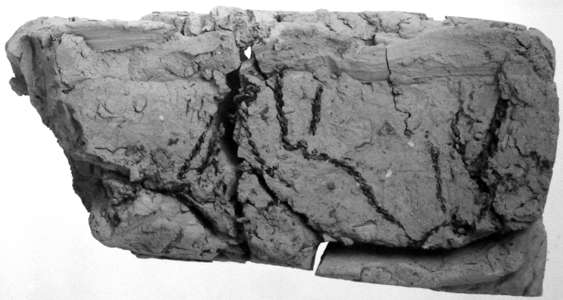
A photograph of the net from a display in the museum.
Photo: Ralph Frenken
Source: The National Museum of Finland, Suomen kansallismuseo presents Finnish history from the Stone Age to the present day, through objects and cultural history.
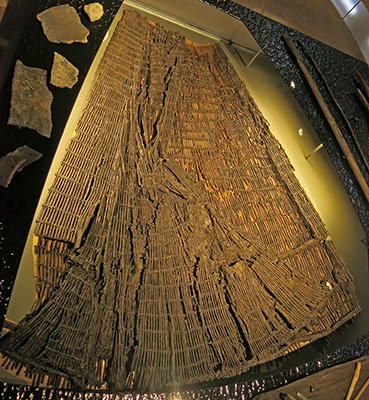
Middle Neolithic, 6 300 - 6 200 years ago
In a salt marsh near Bergschenhoek in the Netherlands a small hunting encampment lay on the banks of a lake. Different layers in the hearth show that people regularly returned here for ten years. The wet ground was reinforced with the remains of an old canoe and bundles of reed, and there may have been a small hut. Water fowl were hunted with a bow and arrow, usually typical winter visitors such as the small swan and widgeon.
Photo: Don Hitchcock 2014
Source and text: Rijksmuseum van Oudheden, National Museum of Antiquities, Leiden.
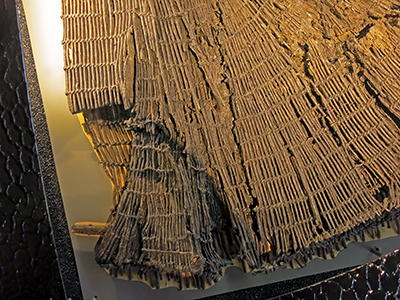
Middle Neolithic, 6 300 - 6 200 years ago
Four fish traps, made locally from the twigs of dogwood, and a fishing spear were spectacular finds. They were used to catch eel, perch, pike, and carp. The group cooked fish soup in pots they brought with them. This spot was an attractive location where hunters and their dogs camped for a brief period each winter. In the Swifterbant culture hunting and fishing remained highly important.
Photo: Don Hitchcock 2014
Source and text: Rijksmuseum van Oudheden, National Museum of Antiquities, Leiden.
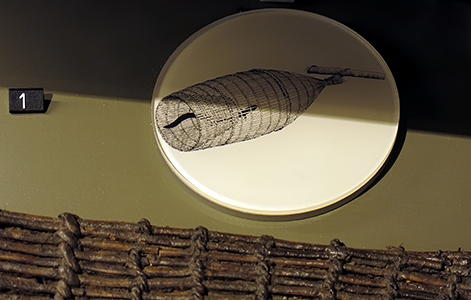
Middle Neolithic, 6 300 - 6 200 years ago
The fish trap is of a design used by some people today.
Photo: Don Hitchcock 2014
Artwork: © Roel Bakker.
Source and text: Rijksmuseum van Oudheden, National Museum of Antiquities, Leiden.
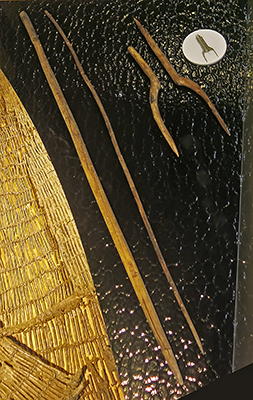
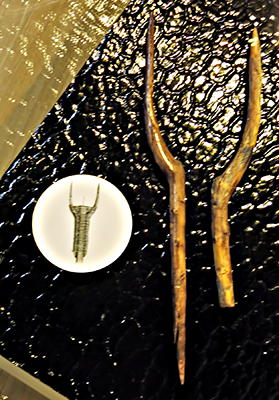
Middle Neolithic, 6 300 - 6 200 years ago
This fishing spear appears to have had three points, the classic trident, two of wood chosen and carved so as to be of a useful shape, with the third point formed of the extension of the spear shaft itself.
Photo: Don Hitchcock 2014
Artwork: © Roel Bakker.
Source and text: Rijksmuseum van Oudheden, National Museum of Antiquities, Leiden.
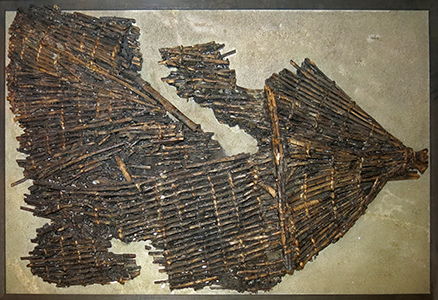
Trap of bound twigs for catching small fish and eels, 4500 BC, from a bog at Lille Knabstrup, Zealand, Denmark, 59 km west of Copenhagen, 55.633333 N, 11.616667 E
( the material used may have been Salix species (willow) and/or the more desirable coppiced Corylus avellana L. (hazel) based on other finds in the Northern Netherlands - Don )
Powerful geological forces have tilted Denmark since the stone age. Settlements that were on the coast 6000 years ago are now 12 metres above sea level in northern Jutland and under 3 metres of water in southern Jutland.
Photo: Don Hitchcock 2014
Source and text: Original, Københavns (Copenhagen) Museum, National Museum of Denmark
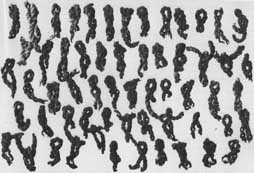
Net Fragments
Photo, and text below from: Excavations near Friesack: an Early Mesolithic marshland site in the northern plain of central Europe, by B. gramsch and K. Kloss in The Mesolithic in Europe, 1985, edited by Clive Bonsall
The use of plant fibres, or bast, has been shown by the bone point hafting in the early Boreal and by the fragments of nets from the same period. The technique of net manufacture shown above has so far only been seen in the Neolithic of Switzerland and Denmark and, more recently, at the early Ertebolle site of Tybrind Vig on the Danish island of Funen (Andersen and Bender Jorgensen 1985). Whether the Friesack nets were for fishing or carrying purposes is not clear. The oldest fragments of bast at Friesack belong to the period around 9600 BP.
Ecology, settlement and economy
The list of fauna so far includes: otter (Lutra lutra), wolf (Canis 1upus), brown bear (Ursus arctos), lynx (Lynx lynx), wild cat (Felis silvestris), wild pig (Sus scroja), red deer (Cervus elaphus), roe deer (Capreolus capreolus), elk (Alces alces), aurochs (Bos primigenius), beaver (Castor fiber), hare (Lepus europaeus), pike (Esox lucius), catfish (Siluris glanis), European pond tortoise (Emys orbicularis), and large species of birds - mostly water birds. Human remains are so far represented only by a small skull fragment and some perforated teeth.
The main animals hunted were red deer, roe deer and wild pig, but there are also significant quantities of beaver and tortoise remains. There are a few elk remains in the Pre-Boreal, and fish are not numerous.
The environment around the site in the early Postglacial period has been reconstructed from evidence of pollen and sediment borings (Kloss 1987a, 1987b). Around the inhabited sand hill were small, reed-fringed lakes, sandy areas, marshes, and birch woods. The sandy areas had pine woods of varying density.
It was vital for human occupation that the small, shallow lakes were more and more organically productive as the climate became warmer, contributing to a rich flora and fauna, and above all providing food for fish and birds, and eventually man. These small, shallow lakes were thus more important to the contemporary economy and settlement than larger, deeper, and thus colder, bodies of water.
In the Boreal period, the vegetation of woods and marshes were of equal importance. Reeds were the main vegetation type in treeless areas, but there were also areas free of trees on the sand hills in the wet, low-lying areas.
In the late Boreal and early Atlantic, mixed-oak forest became more significant. There was a marked reduction in pine, birch and hazel, and ash appeared. Water bodies diminished due to the progressive Verlandung (silting up) of the area, with the development of eutrophic vegetation, particularly broad-leaved reeds (Typha latifolia).
The sediments near the margins of the water to the east and south of the hill suggest discontinuous occupation of the site. Anthropogenic sediments intercalated with undisturbed 'natural' layers indicate times when people were absent. The following settlement phases are indicated: middle to late PreBoreal (9700-9450 BP) - approximately 15 settlement episodes; Pre-Boreal/Boreal transition (93509150 BP) - approximately five settlements; early Boreal (9050-8800 BP) - approximately 15 settlements; late Boreal to early Atlantic (8150-7000 BP) - approximately five settlements, separated by long intervals.
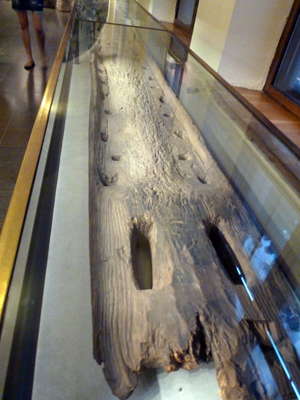
A Sledge-Runner from Lapinlahti
The runner is of Finnish pine and was discovered in 1949 at Koppola in Lapinlahti, East Finland. It is 523 cm long and belonged to a single runner sledge of the construction shown in the drawing. The sledge may have been transported by pushing from the rear and pulling at the sides. A rope at the front was used for steering. Possibly 5 - 6 men were required for moving the sledge. A radiocarbon date of the runner indicates that it was made between 4060 and 3950 BC.
Photo: Ralph Frenken
Source: Display, Helsinki Museum

This is a drawing of what the Sledge-Runner from Lapinlahti may have looked like.
(My best guess is that it was used to transport large heavy logs from the forest back to the home site in order to work on them further - Don )
Photo: Ralph Frenken
Text and source: Display, Helsinki Museum
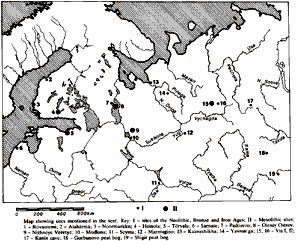
Map
Photo, and text below from: Excavations near Friesack: an Early Mesolithic marshland site in the northern plain of central Europe, by B. gramsch and K. Kloss in The Mesolithic in Europe, 1985, edited by Clive Bonsall
THE VIS SITES
An ideal place for archaeological excavations is the region of Lake Sindor in the Vychegda basin. Exploratory excavations were started in 1960 and continued in 1962 (Burov 1967). They revealed two horseshoe-shaped, ox-bow peat bogs relating to the Simva and Vis rivers (the latter is an outlet of Lake Sindor), in which many wooden artefacts have been found. These peat bogs are located at the howshaped edges of the higher ground on which two multi-period settlements, Vis I and II, existed for a long time (Fig. 1, sites 15, 16). The peat bogs are 1620 m wide; the length of the first is 150 m and of the second 250 m; the maximum depths are 1.6 m and more than 3.3 m, respectively.
In the peat bog adjacent to the site of Vis 1, 168 organic (wooden, bark, sedge) objects and 39 pieces of wood with traces of working were found in 1960-67. These finds date back to the period 8300-7000 BP. Five radiocarbon dates for the bog were obtained: 8080 ± 90 BP (LE-776), 7820 ± 80 BP (RUL-616), 7150 ± 60 BP (LE-684), 7090 ± 80 BP (LE-685) and 7090 ± 70 BP (LE-713) (Burov et al. 1972). The dates were obtained on wooden artefacts and pieces of wood with traces of working - in one case (RUL616) the dated sample was a log found at a level below a sledge runner, but above a bow.
In the middle layers of peat bog II (Vis II) weirs made of stakes and horizontal rods were discovered in 1962-66, together with a large quantity of ceramics of the Vanvizdino culture (AD 400-600), hundreds of wooden and birch bark objects, and bone and glass artefacts.
In 1968, along the bow-shaped edge of the hillock on which the site of Yavron'ga I (in the Pinega basin) is situated, the present author found an oxbow peat bog containing remains of fish weirs and a fragment of a simple bow dating from the Iron Age (Burov 1974a). In 1966 an infilled ox-bow lake at the village of Marmugino on the Yug river (a tributary of the Northern Dvina) revealed Neolithic fish traps made of wooden laths. Radiocarbon determinations indicated a date of c. 5000-4500 BP (Burov 1969; Burov et al. 1972).
WOODEN ARTEFACTS FROM VIS I
Since organic artefacts are extremely rare in sites dating back to the period 9000-7000 BP anywhere in the world, the extensive collection from Vis I assumes considerable significance. It includes, among other objects, a variety of sledge runners and skis, bows for hunting and other purposes, arrows and spears, throwing-sticks, hoops of landing-nets or fish traps, a wooden disc from an implement for frightening fish (botalo), an oar, an arched scraper, and a series of stakes. Also found were a fragment of a fishing basket or mat, a net made of sedge fibre, a pine bark float and a birch bark vessel (Burov 1964, 1966a, 1966b, 1967, 1968, 1973a, 1973b, 1981a, 1981c).
Skis
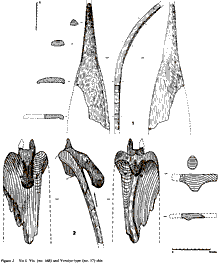 Photo, and text below from: Excavations near Friesack: an Early Mesolithic marshland site in the northern plain of central Europe, by B. gramsch and K. Kloss in The Mesolithic in Europe, 1985, edited by Clive Bonsall
Photo, and text below from: Excavations near Friesack: an Early Mesolithic marshland site in the northern plain of central Europe, by B. gramsch and K. Kloss in The Mesolithic in Europe, 1985, edited by Clive Bonsall
One group of artefacts made of hardwood is represented by a series of end fragments. When whole, these appear to have tapered gradually, with a projection resembling the prow of a ship at one end. The end was noticeably turned up a result of its having been cut out of a massive log divided into two. The flat lower surface, corresponding to the flat face of the split log, became convex as it tapered. There was a slight projecting rim, or flange, along both edges on the upper surface; while the upturned projection at the front end was triangular in section. There were no holes in these artefacts. The largest fragment (which measures 45 cm in length) comes from an object more than 15 cm wide, and the end is turned up more than 14 cm (Fig. 2, no. 1). Three of the fragments are ornamented;the edges and underside of the upturned end are covered with notches, while the upper surface is engraved with zig-zags.
It is evident that these are fragments of winter means of transportation. The absence of holes in the fore-part, the symmetry of the artefacts, and the flat lower surface allow them to be interpreted as skis, rather than as sledge runners. The sharply upturned end of the Vis I objects is reminiscent of east Siberian Yakut skis, known from a seventeenth century print reproduced in a book by N. Witsen (Antropova 1953: fig. 1), which some authors have considered to be unbelievable. The Vis I artefacts have no archaeological analogues. In some respects, however, they resemble the Heinola-type hardwood sledge runners (examples of which have been found at Heinola, Finland, and at Vis 1) which are arched in profile, with a sharply curved fore-part, a projecting rim along one edge, and holes through the ends for fastening them together in pairs using straps (Burov 1981c: fig. 4).
There is also an unusually finely-made object in the collection (Fig. 2, no. 2; Fig. 2a) which differs greatly from the Vis-type skis described above, but possesses some features in common with runners of the Vis type which resemble those of toboggans used by Canadian indians (Burov 1981c: fig. 5). In both cases softwood was used; the lower surface is flat; the fore-part is not sharpened, but is turned up and has a pair of small holes (0.2-0.3 cm in diameter) bored from both surfaces. On the lower surface there is also a carved projection bevelled backwards. Almost the whole of the lower surface is covered with marks left by a shaving instrument (arched scraper or 'spokeshave') fitted with worn microliths' - this has been proved experimentally.
There are a number of differences between this object and skis of the Vis type: the absence of a rim along the edges; the presence of a ridge in the form of a wave pattern 0.6 cm high along the middle of the upper surface, which adds to the strength of the object; and the presence of a projection in the form of an elk's head. The crown and ears of this sculpture are placed in a specially-made hollow in the front end, while the neck is represented by a protruberance, extending from which is the wavy ridge. The absence of lateral flanges, the width (which is not less than 12.5 cm), and the wavy ridge testify to the fact that this object served as a ski and not as a sledge runner. Moreover, indisputable runners of the same style (Vis-type runners) were also found in the peat bog.
The pair of holes was probably used for attaching a belt when going downhill. As an Arabian traveller, Abu-Hamid, wrote in the twelfth century about the skis of the northern Urals and the region beyond the Ural mountains:
Both small planks, which are put on the feet, are bound together with a long belt looking like a horse's bridle which is held in the left hand (Mongayt 1965: 35-36).
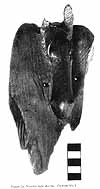 Photo, and text below from: Excavations near Friesack: an Early Mesolithic marshland site in the northern plain of central Europe, by B. gramsch and K. Kloss in The Mesolithic in Europe, 1985, edited by Clive Bonsall
Photo, and text below from: Excavations near Friesack: an Early Mesolithic marshland site in the northern plain of central Europe, by B. gramsch and K. Kloss in The Mesolithic in Europe, 1985, edited by Clive Bonsall
The carved elk's head (moose's head) projection, which was bevelled backwards, also had a practical use. Being lower than the gliding surface of the ski, it would have prevented the reverse movement of the ski over packed snow. It would also have served as a stabilizer preventing the lateral displacement of the ski end. In recent times (nineteenth and twentieth centuries AD), Siberian and certain other peoples covered the lower ski surface with fur and edged their skis with flat strips of wood (nashchep) for the same purpose (Antropova 1953). The effectiveness of these devices has been proved by experiments.
At the same time, the sculpture of the elk's head probably symbolized rapid movement. In this respect, the Vis find may be compared with the late Neolithic runner from Noormarkku in Finland which is crowned by a sculpture of an elk's head (Salo 1967), and to ancient ships with prows in the form of a bird's head. It may be supposed that the people believed that these sculptures made skiing easier.
The brake in the form of an elk's head on this second type of Vis ski is a masterpiece of Mesolithic applied wooden sculpture. The ears and muzzle are reproduced very realistically, with bulges corresponding to the eyes and the lower lip. The surface of the head has been smoothed with an indented shaving instrument. The lower surface of the ski is covered with marks of longitudinal shaving, and the upper surface has wavy shave marks along the central ridge. Antler sculptures of the elk from the Mesolithic burial site of Oleniy Ostrov (Gurina 1956: figs. 113, 114, 118, 131) are similar to the Vis I sculpture. There are also parallels among the plastic art of later times, mainly of the Neolithic and Bronze Age. Four wooden artefacts from sites in the area beyond the Ural mountains and from Finland are of particular interest - namely, the sculpture of the sheelk from the Gorbunovo peat bog (Raushenbakh 1956: fig. 3; Moshinskaya 1976: fig. 14), a carved bucket with a handle in the form of an elk's head from the Shigir peat bog (Moshinskaya 1976: plate 13), the runner with an elk's head sculpture on the front end from Noormarkku (similar to that from Vis 1), and the sculpture of an elk's head from Rovaniemi (Era-Esko 1958; HyypAA 1958). The Shigir bucket is undated, but the other objects are dated to the Neolithic. In addition, an antler sculpture of an elk from the Shigir peat bog (Moshinskaya 1976: fig. 10) which has parallels in Finland (Ailio and Hackman 1911: 118, fig. 21), a stone head from the Modlona site (Oshibkina 1978: plate 51), a shaft-hole axe with the butt in the shape of an elk's head from Padozero in Karelia (Aspelin 1877: no. 72), and a bronze dagger with a pommel shaped like an elk's head from the Seyma burial ground in the Volga-Oka region (Bader 1970: fig. 50) are all analogous to the Vis I sculpture.
Almost all of the sculptures mentioned above are similar to the Vis I sculpture in the form of the muzzle. Exceptions are the carved butt of the Padozero axe and the head from burial no. 153 at Olemy Ostrov, although the latter is similar to the Vis I sculpture in the form of the ears. Sculptures which have eyes without hollows to represent pupils are particularly close to the Vis I sculpture - specifically, the carved protruberance of the Noormarkku runner, the shaft of the Shigir bucket, and the pommel of the Seyma dagger.
The Seyma dagger provides a clue to the significance of the wavy ridge decorating the upper surface of the Vis I ski. In the Mesolithic antler and bone plastic art of north-eastern Europe (Oleniy Ostrov, Torvala) only the images of man, elk and snake occur (Gurina 1956, 1961). This fact allows us to regard the wavy ridge as a relief image of a reptile. The cult of the snake was preserved throughout the Neolithic - finds at sites in the eastern Baltic region (Loze 1973; Vankina et al. 1973) and in the Gorbunovo peat bog (Raushenbakh 1956) testify to this. Daggers of the Seyma type (Bader 1970: fig. 50; Chernykh 1970: 164, fig. 59), dated to 1500-1200 BC, bear images of the snake; moreover, on the hilt of the Seyma site dagger, as well as on the ski from Vis 1, the snake stretches from the head of an elk Thus, these subjects are probably linked with a cult involving the elk and reptiles which lasted for thousands of years.